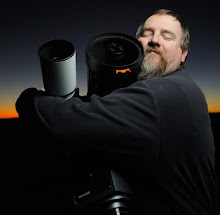
The Cone Nebula (also known as NGC 2264) is an H II region in the constellation of Monoceros. It was discovered by William Herschel in 1785. The nebula is located about 800 parsecs or 2,600 light-years away from Earth.
The Cone Nebula is part of the nebulosity surrounding the Christmas Tree Cluster. The designation of NGC 2264 in the New General Catalogue refers to both objects and not the nebula alone.
The diffuse Cone Nebula, so named because of its apparent shape, lies in the southern part of NGC 2264, the northern part being the magnitude-3.9 Christmas Tree Cluster. It is in the northern part of Monoceros, just north of the midpoint of a line from Procyon to Betelgeuse.
The cone's shape comes from a dark absorption nebula consisting of cold molecular hydrogen and dust in front of a faint emission nebula containing hydrogen ionized by S Monocerotis, the brightest star of NGC 2264. The faint nebula is approximately seven light-years long (with an apparent length of 10 arcminutes), and is 2,700 light-years away from Earth.
William Herschel discovered the Cone Nebula (which he designated H V.27) on December 26, 1785. It is part of a much larger star-forming complex—the Hubble Space Telescope was used to image forming stars in 1997.
I'm disappointed in this image after having M45 come out so well.
Heritage Park Observatory, Cedar Park, TX
Exposure: 19 x 5 minutes
Camera: Modified Canon Digital Rebel XT (350D)
Scope: Astro-Tech AT80ED 80mm APO refractor, William Optics 0.8 FFIII field flattener (new!)
Mount: Meade LX200
Guider: Meade LX200 @ f/5, Meade DSI
Filter: Astronomik CLS
Software: PHD Guiding, Nebulosity, Photoshop





No comments:
Post a Comment